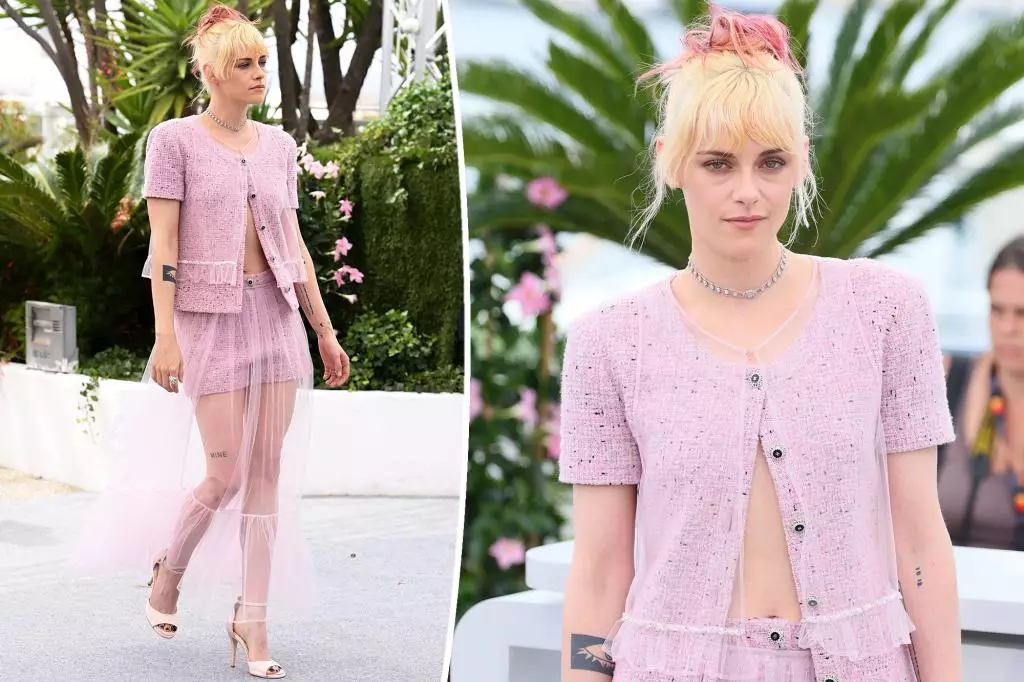The Cannes Film Festival, a prestigious gathering known for its glamour and iconic red carpet moments, has long been a platform where stars showcase not only their films but also their personal style. Recently, new guidelines have emerged concerning attire at the festival, inciting spirited discussions about fashion, freedom, and expression. While nudity is strictly off-limits and flamboyant gowns are discouraged, Kristen Stewart has navigated this minefield with her own unique flair, sparking intrigue and admiration.
Stewart, who made headlines yet again as she attended the premiere of “The Chronology of Water,” her directorial debut, wore a light pink sheer maxi skirt layered over a tweed short suit. The combination was expertly styled by her long-time collaborator, Tara Swennen. Though the festival’s new dress code aims to create a more structured environment on the red carpet, Stewart’s ensemble was a delicate balancing act—showing creativity without crossing any lines. Her thoughtful layering allowed her freedom of movement while adhering to the rules, prompting discussions about what constitutes true style under constraint.
Bold Choices: Stewart’s Statement on Restriction
Stewart, now 35, has long been a figure of quirkiness and offbeat fashion choices in Hollywood. Flashback to 2018, when she made a bold statement by walking barefoot on the red carpet in protest of the festival’s previous ban on flat shoes. This year, her unconventional take on the current dress code hints at a subtle defiance fused with intelligence. One could argue that Stewart’s layered approach to fashion speaks volumes about the desire for expression, despite the stringent guidelines imposed by the festival.
The juxtaposition of her sheer skirt with a structured short-sleeve tweed blazer not only showcased her style but also illustrated her adeptness in working within boundaries. By employing such an innovative mix, Stewart manages to reveal personal elegance while staying within the confines set by organizers. The iconic Chanel detail of her outfit, accompanied by a stunning diamond choker and pink pumps, created the perfect symphony of sophistication and fun, reinforcing her identity as a trendsetter unafraid to challenge norms.
Fashion Fallout: The Divide at Cannes
While Stewart navigated the rules expertly, not everyone adhered to the new guidelines. Heidi Klum, an elder stateswoman of the fashion world, embraced her own rebellious spirit by flaunting a breathtaking Elie Saab gown that breached the newly imposed regulations surrounding voluminous outfits and trains. Her look, with its expansive floral design and dramatic train, sparked outcry not just for its beauty, but for its audacity, prompting questions about the purpose of such codes in a creative setting.
Halle Berry, another esteemed personality at the festival, also faced wardrobe restrictions. The actress’s last-minute outfit change highlights an underlying tension at Cannes, where fashion choices are scrutinized under the lens of regulations. Opting for a striped Jacquemus design instead of her originally intended gown due to size limitations illustrates a subtle defeat of artistic expression, and yet Berry still maintained a chic appearance, proving that versatility can be achieved even under constraint.
Personal Moments Amidst the Glamour
Amid the glitz of Cannes, Stewart’s recent marriage to screenwriter Dylan Meyer offers a glimpse into her personal life juxtaposed against a world of opulence. The couple celebrated their love with an intimate ceremony, with Stewart donning a casual yet stylish ensemble that deviates markedly from the norm of celebrity weddings. This deviation reflects her approach to public life—asking that we see not just the glam, but the essence of genuine connection and self-identity.
Fashion, particularly in a high-stakes environment like Cannes, often becomes a signifier of larger societal trends, revealing layers of meaning behind each outfit choice. Stewart’s masterful integration of rule-bending style, Klum’s lavish exuberance, and Berry’s wardrobe shake-up all contribute to a narrative where individuality wrestles with conformity. The festival serves not just as a backdrop for cinema, but as a complex stage for the interplay of fashion, identity, and cultural dialogue, making every ensemble a conversation worth engaging in.

